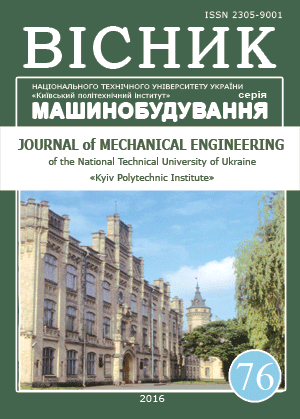OPTIMIZATION OF END MILLS PERIPHERY MILLING
DOI:
https://doi.org/10.20535/2305-9001.2016.76.61261Keywords:
optimization of the peripheral milling, mathematical model, roughness, cutting forceAbstract
A mathematical model is developed for optimization of process of the peripheral milling, which contains the digital method of determination of cutting force, and also equalizations relating limitations with the guided parameters of the cutting mode: by frequency of rotation of spindle and feed-rate. It is well-proven that the roughness of surface does not depend on the geometrical constituent of type, appearing at moving of points milling cutter on a cvasytrohoid, and determined maximal amplitude and frequency of spectrum of cutting force, and also by frequency descriptions of the technological processing system. The optimum mode of cutting is formed in area of legitimate values of phase space «frequency of rotation – feed-rate» mainly by two limitations: on firmness of instrument and on a roughness. The application program is created for the automated determination of the optimum mode of cutting at the peripheral milling of steels, cast-irons and easy alloys on the basis of aluminum.References
Petrakov, Y.V. and Drachev, О.I. (2014), Avtomatichesroe upravlenie processami rezania. ТНТ-Press, Kiev, Ukraine.
Petrakov, Y.V., Маckivski, О.S. (2015), Modeluvannia systemi adaptivnogo upravlinnia frezeruvanniam na verstati z CHPK, Visnyk NTUU “KPI”, seria mashinobuduvania. 74, pp.146-152.
Yaschericyn, P.I., Feldshteyn, E.E. and Kornievich, М.А. (2005), Теоria rezania. Novoe znanie, Minsk, Ukraine.
Dalskogo, А.М., Коsilovoi, А.G., Меscherakova, Р.К. and Suslova, А.G. (2003), Spravochnik tehnologa-mashinostroitelia, Маshinostroenie-1, Moscow, Russia.
Petrakov, Y.V., Drachev, O.I. (2013), Modelirovanie processov rezania, ТНТ-Press, 240p.
Petrakov, Y.V., Маckivski, О.S. (2015), Modeluvannia frezeruvannia kincevimi frezami, Visnyk NTUU “KPI”, seria mashinobuduvania, 73, pp.78-83.
GARANT Spravochnik po obrabotke rezaniem www.garant-tools.com.
Mazur, М.P., Vnukov, Y.N., and Dobroskok, V.L. (2010), Оsnovy teorii rizannia materialiv, Novyi Svit, Lviv, 412p.
Lukianenko, O.L. (2014), Vizualizacia formirovania sherohovatosty pri koncevom frezerovanii tonkostennih detaley, Novi materialy i tehnologii v metalurgii ta mashinobuduvanni, 2, pp. 52-60.
Husu, A.P., Vitenberg, Y.R. and Palmov, V.A. (1975), Sherohovatost poverhnostey (teoretyko-veroyatnostniy podhod), Nаukа, Moscow, Russia.

